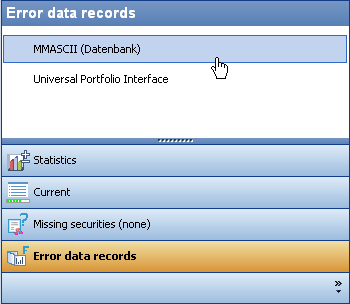Error data records
If (consistency) errors occurred during the data import, then you can use this function to identify them without repeating the import and without searching in the log. The error data record graph provides a detailed overview of the type of errors and their numbers.
This function is only available for interfaces that use the "Error buffer" add-on and for which the "Error buffer enabled" checkbox is selected in the settings on the "Error buffer" tab.
Open the analysis of the erroneous data records after an import as follows:
- Click the "Error data records" button in the information bar. For more information, see Information bar.
- Then select the bank whose data you have imported from the information bar above.

The left-hand window now displays an overview of this bank's erroneous data records. The height of the bars in the diagram indicates the number of errors.
- You can now either rectify the errors or - if they are irrelevant - delete them using the "Delete all data records" or "Delete selection" buttons.
- Use the "Save changes" button to save the settings you have made.
- Use the "Reimport all" or "Reimport selection" buttons to start a new data import if necessary. Then you can display the error data records again for monitoring.
The data records are divided as following in this overview:
- Folders
- Groups
- Holder
- Holders without address
- Portfolios
- Addresses
- Accounts
- Securities accounts
- User-defined fields
- Orders
- Income
- Postings
- Kickbacks
- Positions
- Balances
- Security prices
- Securities
- Historical average purchase prices
- Info
- Securities reference mapping
In the error buffer, (only) the transaction-related data records (postings, orders, income, historical data) can be edited.
